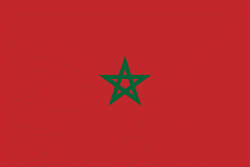Ouarzazate
Ouarzazate (ورزازات, ; وارزازات; ), nicknamed the door of the desert, is a city and capital of Ouarzazate Province in the region of Drâa-Tafilalet, south-central Morocco. Ouarzazate is at an elevation of 1160 m in the middle of a bare plateau south of the High Atlas Mountains, with a desert to the city's south.
Berber-speakers make up the majority of the town's inhabitants, who were responsible for the creation of many of the prominent kasbahs (locally referred to as: iɣeṛman). Ouarzazate is a primary tourist destination in Morocco during the holidays, as well as a starting point for excursions into and across the Draa Valley and the desert. Aït Benhaddou (a fortified village) west of the city is a UNESCO World Heritage Site.
The Ouarzazate area is a noted film-making location, with Morocco's biggest studios inviting many international companies to work here. Films such as Lawrence of Arabia (1962), The Man Who Would Be King (1975), The Living Daylights (1987), The Last Temptation of Christ (1988), The Mummy (1999), Gladiator (2000), Kingdom of Heaven (2005), Kundun (1997), Legionnaire (1998), Hanna (2011), The Hills Have Eyes (2006), and Salmon Fishing in the Yemen (2011) were shot here, as was part of the TV series Game of Thrones.
The nearby Ouarzazate solar power station, co-funded by the Arab League, was connected to the Moroccan power grid in February 2016.
Its name comes from a Berber phrase meaning "without noise" or "without confusion".
Berber-speakers make up the majority of the town's inhabitants, who were responsible for the creation of many of the prominent kasbahs (locally referred to as: iɣeṛman). Ouarzazate is a primary tourist destination in Morocco during the holidays, as well as a starting point for excursions into and across the Draa Valley and the desert. Aït Benhaddou (a fortified village) west of the city is a UNESCO World Heritage Site.
The Ouarzazate area is a noted film-making location, with Morocco's biggest studios inviting many international companies to work here. Films such as Lawrence of Arabia (1962), The Man Who Would Be King (1975), The Living Daylights (1987), The Last Temptation of Christ (1988), The Mummy (1999), Gladiator (2000), Kingdom of Heaven (2005), Kundun (1997), Legionnaire (1998), Hanna (2011), The Hills Have Eyes (2006), and Salmon Fishing in the Yemen (2011) were shot here, as was part of the TV series Game of Thrones.
The nearby Ouarzazate solar power station, co-funded by the Arab League, was connected to the Moroccan power grid in February 2016.
Its name comes from a Berber phrase meaning "without noise" or "without confusion".
Map - Ouarzazate
Map
Country - Morocco
 |
 |
| Flag of Morocco | |
In a region inhabited since the Paleolithic era over 300,000 years ago, the first Moroccan state was established by Idris I in 788. It was subsequently ruled by a series of independent dynasties, reaching its zenith as a regional power in the 11th and 12th centuries, under the Almoravid and Almohad dynasties, when it controlled most of the Iberian Peninsula and the Maghreb. In the 15th and 16th centuries, Morocco faced external threats to its sovereignty, with Portugal seizing some territory and the Ottoman Empire encroaching from the east. The Marinid and Saadi dynasties otherwise resisted foreign domination, and Morocco was the only North African nation to escape Ottoman dominion. The 'Alawi dynasty, which rules the country to this day, seized power in 1631, and over the next two centuries expanded diplomatic and commercial relations with the Western world. Morocco's strategic location near the mouth of the Mediterranean drew renewed European interest; in 1912, France and Spain divided the country into respective protectorates, reserving an international zone in Tangier. Following intermittent riots and revolts against colonial rule, in 1956, Morocco regained its independence and reunified.
Currency / Language
| ISO | Currency | Symbol | Significant figures |
|---|---|---|---|
| MAD | Moroccan dirham | د م. | 2 |
| ISO | Language |
|---|---|
| AR | Arabic language |
| FR | French language |















